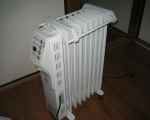What better oil cooler or convector. For water heating. Which heater is better - a convector and an oil radiator
What is better convector or oil heater: a review of models. Central heating is not always enough to provide a comfortable atmosphere in the house. Therefore, it is often necessary to use additional heating devices. The most popular of them are the convector or the oil heater: which is better - you can decide by getting acquainted with the advantages and disadvantages of these devices, as well as the features of their use.
Avoid blocking heaters. Do not install furniture or curtains in front of radiators. To keep warm, close curtains, blinds and shutters at night. Conversely, on the same day, let the sunlight warm your home. Regular maintenance can save you a lot. Check, clean and maintain your stoves and boilers once a year at the end or before the heating season.
Vacuum on baseboard heaters and inside it. Removing dust increases durability and minimizes the smell of burning that occurs when the heater is activated. In addition, wipe off hot air systems and clean the filters. For hot water radiators, clean them every early winter season and be looking for leaks and rust.
Heaters can be both the main and additional source of heat
The principle of operation, the pros and cons of an oil heater
When choosing an oil heater for the house should understand the principle of its work. Externally, it is a metal case, inside which is a container with mineral oil. After turning on the device, the heating element starts working, which raises the temperature of the oil. Oil, in turn, heats the metal body, and it gives its heat to the environment. It takes quite a lot of time, but the heat evenly spreads throughout the room.
Chimney flue regularly if you heat the wood, but also with oil. Lower the temperature, especially at night, into unused rooms, as well as during your absence on the day or on the weekend. Be careful not to lower the heater too much.
The level of environmental humidity may increase, causing problems with condensation or even the formation of mold. Home Energy Efficiency. You can take advantage of inexpensive energy assessment, as well as financial assistance. Type of heating by energy source.
Electric heating. Easy, fast and inexpensive installation. Programming and management systems. Aesthetics: a large selection of radiators. Pleasant and uniform heat. Low maintenance costs. Individual heating. Relatively high cost of use: power consuming devices.
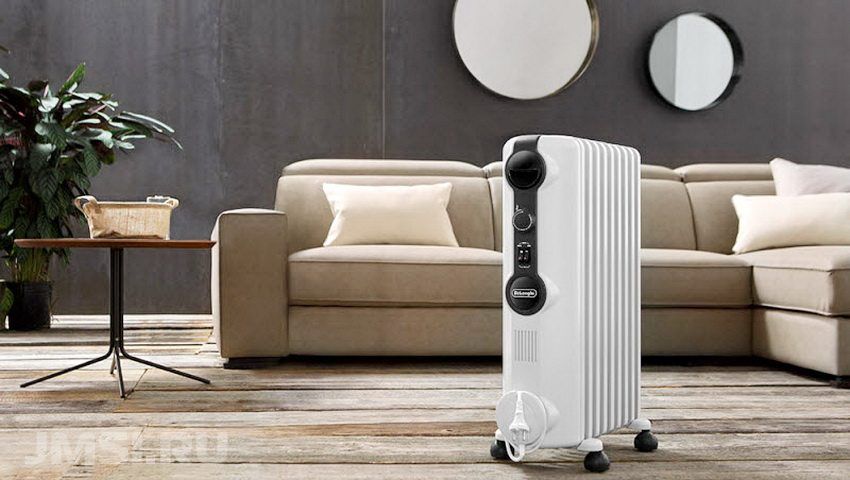
Oil heater heats the room slowly but evenly
The intensity of air heating in such radiators is, as a rule, regulated, and the design is equipped with wheels for greater mobility. There are floor and wall oil heaters. Buy the latter is advisable if the house has a small child or pets.
This heater works for periods. When the room temperature rises to the desired level, the integrated sensor turns off the heating element. When the temperature decreases, the reverse occurs. Thus, the use of electric oil radiator saves energy.
Heat irregular. Large footprint. Watch out for power outages. Heated fossil fuels and heated oil. Price, one of the most expensive fuels in Quebec. Price fluctuations in relation to the price of oil. Requires storage space for fuel oil.
Requires proximity to the hull to connections to the natural gas network. Wooden heating: stove, hearth. Adjustable and equipped installation. Installing a new wood stove has been banned on the island of Montreal since. Requires storage space for wood.
Isolator for outlet or switch: about 80 cents each. Today there are many different types of heating elements, but let's face it, the most popular radiators and convectors. If you are wondering what is the optimal choice between radiators and convectors, it would be helpful to know exactly what differences are. This is what we offer.
Of the advantages of the oil cooler are the following:
- High security - all heating elements are hidden inside the case, so you can not be afraid to burn yourself on the oil heater. In addition, most models are equipped with a special sensor that turns off the device when overturning.
- No noise at work - you can safely install a household electric oil heater in the bedroom or office. Also, the device takes up little space, and you can arrange it not only on the floor, but also on the wall.
- Long service life - the heating element of the oil radiator is reliable and durable, and the device itself can work for several days without interruption. Most modern models are equipped with built-in overheating protection.
- During the work the unpleasant smell is not emitted. In addition, modern oil heaters (Delongy and other companies) do not overdry the air in the room, so complete with the device you do not have to buy a humidifier.
- The price of the heater is quite low, so everyone can afford it.
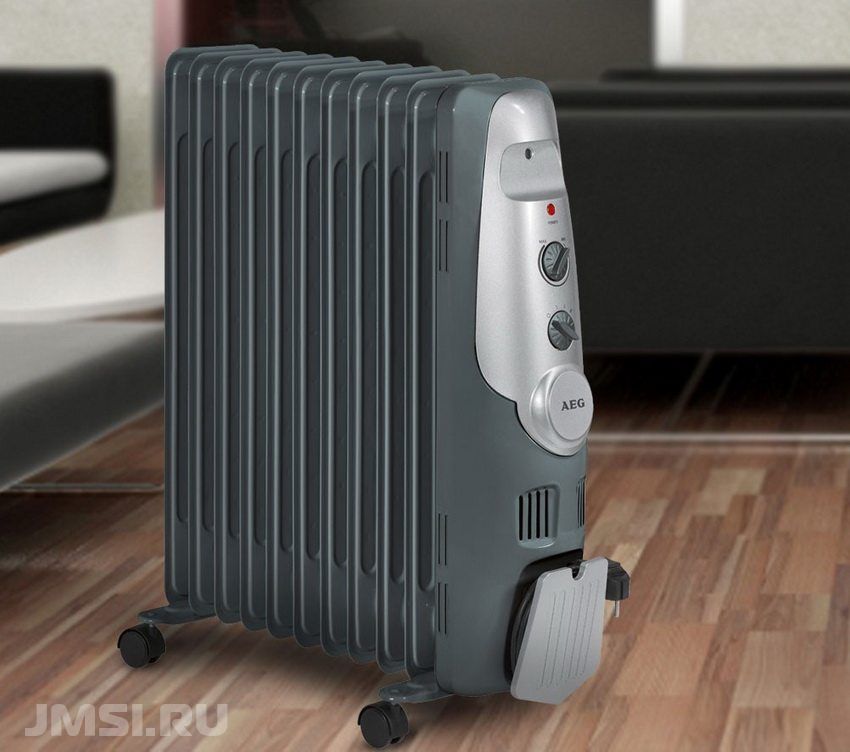
The biggest difference is the mode of operation.
In the radiator, hot water circulates in pipes or panels. Hot water heats the pipes or panels, which in turn heats the surrounding air. The heat generated in the room is a combination of radiant heat and convective heat.
Convectors also use hot water, but work differently. Indeed, they mostly produce convective heat. Due to the vacuum, the convector removes cold air from below and creates a hot air circulation system. Hot water circulates in a thin pipe under the appliance, which is surrounded by aluminum strips. They increase the surface area of contact with ambient air and act as a heat exchanger.
Oil coolers have many advantages, such as quietness, economy and safety.
Like any household appliance, an oil heater has its drawbacks. Among them are:
- The air in the room warms up long enough, especially when it comes to a large room. This problem can be corrected if you buy an oil heater with a fan: the heated air will spread faster.
- The design itself weighs quite a lot, so it is better if the device is equipped with wheels. On the wall to hang the oil heater is only with reliable fasteners.
Helpful advice! When choosing an oil heater, pay attention to the manufacturer. As a rule, brand awareness is guaranteed by the high quality of the heater.
What are the benefits of radiant heat?
Radiant heat or radiant heat consists of horizontal heat waves that heat the surrounding air. This is, therefore, a form of direct heating. Convective heat is a form of indirect heating. The heater attracts cold air and heats it. Hot air rises to the ceiling, cools and descends, so that the process can resume.
Great advantage of convective heat? Heat is distributed more evenly than radiant heat. If low power consumption is at the top of the priority list, a convector will be the best choice for you. And if the budget plays a big role, the radiator will be imposed. In addition, there are now radiators that also have low energy consumption! In addition, radiators have a longer service life and more design features.
Varieties of oil heaters: wall and floor
Different models of heaters may vary in power, size, appearance, and other characteristics. For example, depending on the particular location, oil heaters are distinguished, such as:
- wall mounted;
- floor standing;
- desktop
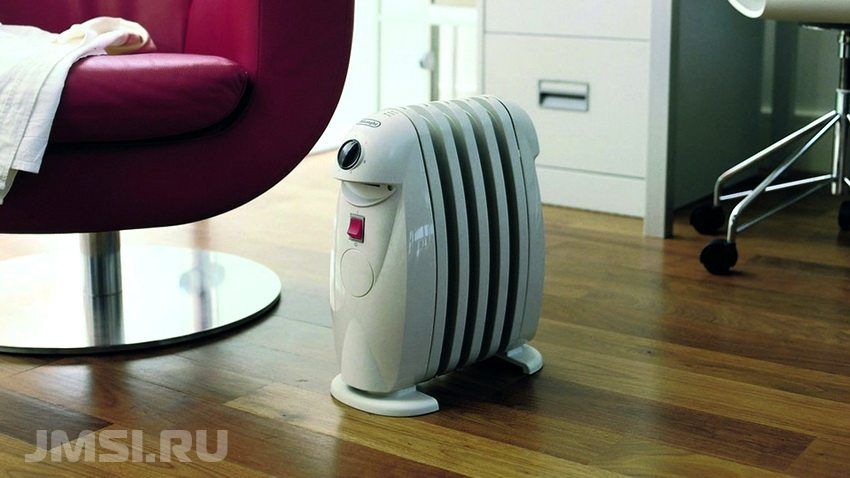
No older cast iron radiator! Technology continues to evolve, so you can always get more comfort and reliability. For example, oil bath radiators, which are lighter and more efficient, can be an excellent additional electric heater. But what are their advantages and disadvantages?
Therefore, strictly speaking, this is a modern technology, even if manufacturers are constantly developing the concept with new functions. Specifically, a heat transfer fluid diffuses by convection into the metal structure of the radiator formed by vertical fins. Thus, the resistance in direct contact with the coolant allows to obtain a very rapid increase in the temperature of the part.
Oil heaters can be of different sizes and types of placement
Using the wall model saves space, but also increases the time required to warm the air in the room. The fact is that the heated air rises, therefore the lower the heater is located, the more efficient it works. Because of this, oil heaters are often installed under the windows.
However, we have to relativize the volume of this type of radiator, which can only be used in the context of additional heating for small surfaces. Indeed, the oil bath radiator should be used ideally to compensate for the lack of temperature in the room, in particular, with a low ceiling height. However, the very mobile design of most liquid inertial heaters gives them a definite advantage.
As a result, there is nothing unusual in that, for example, you can use an oil bath heater used to dry towels in a bathroom. A definite advantage of inertial heaters in general: they continue to dissipate heat even when extinguished.
Outdoor options are the most mobile. They can easily be moved from room to room, cleaned up in unused time. Schemes of oil heaters of floor and wall types practically do not differ between themselves.
In addition, such heaters may have a large number of additional features and capabilities. These include, for example, a fan that accelerates warm air through the room, a humidifier that allows you to create a comfortable level of humidity in the room. And the best oil heaters are equipped with temperature sensors and can be programmed to turn on and off at certain times.
Disadvantages of the oil bath radiator
The main disadvantage of the oil bath heater is the time it takes to heat the room from the moment the system is turned on. However, although the infrared electric heating system is more efficient at this level, it must be recognized that it works better in terms of maintaining the temperature obtained.
Another drawback that may be useful to note is: radiator power consumption. Despite the excellent thermal conductivity of the oil contained in the radiator, you need to carefully monitor your needs, as well as the dimensions of the heated room, even if you choose a programmable thermostat. This way, you can enjoy your radiator longer, while increasing safety in your home. You can not neglect, especially if you have children.

High-quality oil heaters are equipped with temperature sensors, which helps save energy
Calculation of the power of the oil heater with and without a fan
The main criterion when choosing any heater is its power. Therefore, before buying it is necessary to measure all the necessary parameters in order not to overpay, but also not to purchase an insufficiently powerful device. If your apartment has standard ceilings with a height of 2.75 m, then for heating every 10 m². You will need 1 kW of power. With a different ceiling height, the heater power is calculated as:
In general, you will be urged to ask your supplier to find out any features between different radiator models. Be aware that prices for an oil bath radiator can vary from 30 to 150 euros. The ideal cost for small budgets: in some cases it is advisable to spend a little more to capitalize on interesting options.
Belonging to the category of electric radiators, precisely inertial radiators, the oil bath radiator keeps you warm in winter and allows you to enjoy optimum comfort during the rest of the year. Especially recommended as an autonomous heater, it works on the same principle as a conventional central heating radiator. How is this particularly interesting?
- The length and width of the room is measured, its area is calculated.
- The resulting value is multiplied by the height of the ceilings, it turns out its volume.
- The volume is divided into 25, since 1 kW of energy is required for 25 m³.
The resulting figure will be the necessary power for your oil heater. The presence of a fan in the design affects only the heating rate of the room, but not the required power.
Our selection of oil cooler for electric baths
Without further ado, we present to you a choice that we have made from the best radiators that are currently being sold. It consists of one or more electrical resistors, charged by the heat that it contains and in which they are immersed.
Indeed, consisting of a decomposing liquid, thus heated by electrical resistance. This fluid then circulates all over your device to heat the walls. To optimize the heating temperature, it is also equipped with a regulating thermostat.
Oil heater do it yourself
If you want to save money, an oil-type heater can also be made by yourself. For the assembly of an oil heater with your own hands, you need only a metal case. Heating element and oil. The answer to the question what kind of oil in oil heaters to use is purified and heat-resistant.
In addition, by adjusting the performance of your device, you and your heating bill also. In any case, the thermostat supports a function similar to the function of a switch that controls the power source and does not directly affect your consumption.
Oil cooler, what a good choice?
The oil cooler is interesting at several points. The heat it provides is stable from floor to ceiling. He respects your environment and your health, as he does not dry the air that you breathe. Then, like other inertial radiators, it is specifically designed to heat your home. This can only help reduce your electricity bill. Moreover, since no contact is created between its heating elements and the surrounding air, it provides diffuse heat in all the rooms where it is installed.

Scheme of design oil-filled heater
This is necessary so that scale does not form on the walls of the heating element, and the oil itself does not boil at high temperature. If you need to know more precisely what kind of oil can be poured into oil heaters and which cannot, then turn to professionals.
A model equipped with a safety system, in addition to ideal comfort, will prevent the risk of a fire in case of overheating. Thus, even in your absence, you can safely manage your device when necessary. By purchasing one model, it remains practical: it is mounted on wheels, it moves easily from one room to another in order to heat the whole house, despite its considerable weight.
An interesting oil cooler for the price.
Another important point makes the oil bath radiator interesting equipment: its price. It sells on average from 30 euros to 200 euros, which is especially cheap compared to other heaters. And this makes it a profitable investment. However, if this equipment protects its high-yield position of the device, it is also associated with its heat spread over the entire surface of the radiator, which prevents unnecessary energy loss. Do not forget that a model with two independent resistors also allows you to adjust its power.
Helpful advice! As a housing for a homemade heater, you can use a conventional cast iron battery. The material has good thermal conductivity, and inside such a case you can easily install not only the heating element, but also a lot of other useful improvements.
The electric circuit of the oil heater for self-assembly can be easily found on the Internet, and for greater efficiency you need to choose the right heating element. It should be powerful enough, but without a magnesium anode, because it can quickly destroy the heating element. Also when assembling it is necessary to understand the scheme of oil circulation in the device.
Disadvantages that may make the oil bath radiator less interesting
An oil cooler has points that do not necessarily play in its favor. At the same time, the disadvantage lies essentially in the speed of its heating rate, which is rather slow. If you enter an unheated house, it will take some time before your device enters your room.
In addition, the advantage of an oil bath radiator depends on its capacity, the insulation of your house or the volume of the heated room. Of these different criteria actually depends on the warm-up time of your device. Therefore, the latter plays an important role in your consumption.
In order to repair the oil heater with your own hands, it is also necessary to understand the principle of operation of the device and the internal structure of the structure, as well as to have special tools and skills, otherwise repairs may lead to more severe damage. If you are not confident in your abilities, then it is better to entrust this business to experienced specialists.
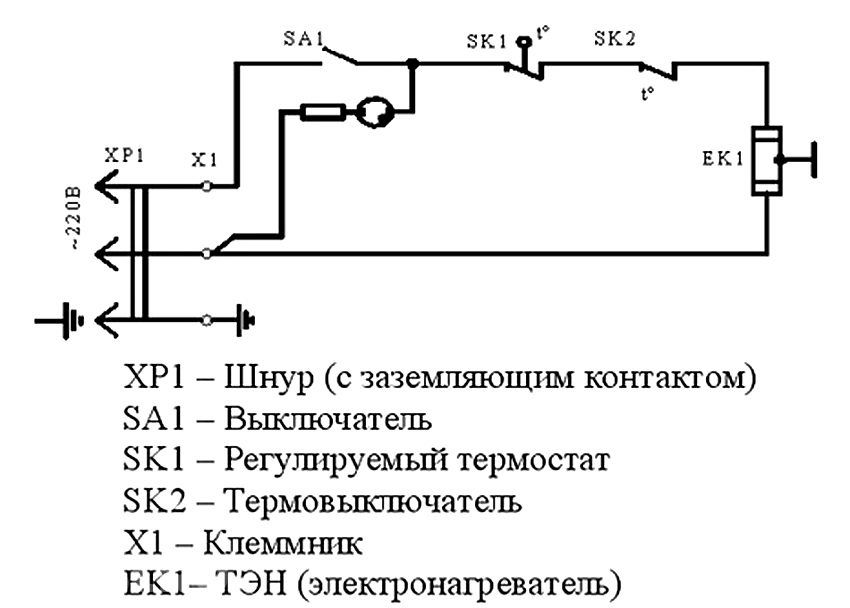
The electrical circuit of the oil cooler
Device and principle of operation of convector heaters
Convector heater is not inferior in design to oil. It also has a heating element that raises the air temperature. The name of the device itself comes from the principle of convection, when warm air rises up and cold air goes down. It is thanks to this air circulation and the room is heated.
On the question of how convectors differ from oil heaters, the answer is very simple - in the first type, the heating element heats up the air directly, rather than the device body. This gives a number of advantages, for example, the device body does not heat up so much. According to the type of energy consumed, electric, gas and water convectors are distinguished, each of which has its own characteristics, but structurally and in power they do not differ much from each other. The most common are electric convector heaters.
There are also infrared convectors that use infrared radiation to heat the air. As a rule, the efficiency of such models is low, so it is best to use combined convective-infrared heaters. They will be able to quickly and evenly heat the air, even in a large room.
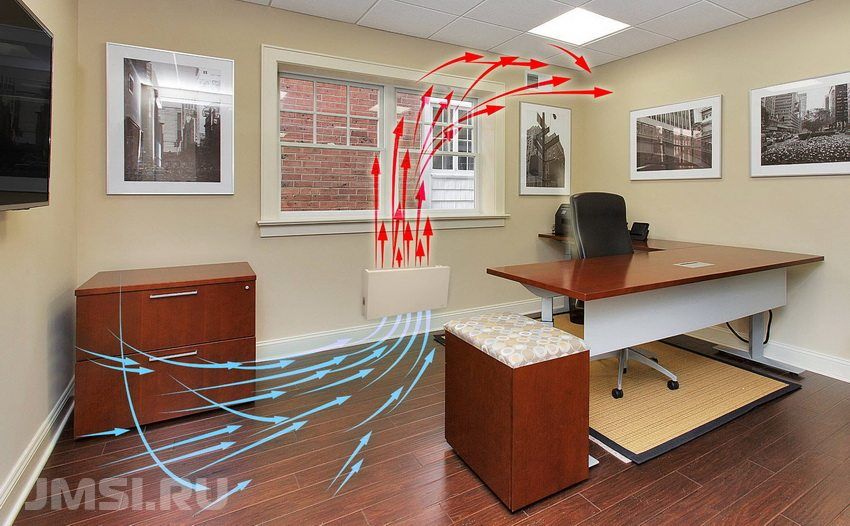
Convector heaters heat the room due to air circulation
Pros and cons of convector heaters
Unlike a floor-mounted or wall-mounted electric oil heater, a convector does not heat the casing, but begins to warm the air immediately. This means that when using such a device, the room temperature rises much faster than when using an oil cooler. With the same power, an oil heater can warm up a large room for up to an hour, while a convector heater can cope in a significantly shorter period of time.
Another advantage - the case of a water, electric or gas convector heater during operation practically does not heat up, which excludes the possibility of getting a burn or damage to property. The use of such a heating device is perfectly safe, even if there are small children in the house. The case itself can be made of various materials with different levels of thermal conductivity.
Separately, it is worth noting the security systems of convector heaters. Virtually every model has power and temperature control, which can be done using an electronic or electromechanical thermostat. Also, many models have protection against high humidity, that is, they can be used not only in living rooms, but also in baths and other rooms with a high level of humidity.

Heaters of convector type are distinguished by the speed of heating of the room, high safety and efficiency
There are some disadvantages of this heater:
- Uneven heating of air at different heights - when using a convector, the difference in air temperature near the floor and near the ceiling can be up to 9-10 ° C, since the heated air immediately rushes up and the cold air stays below.
- Dust circulates with the air, so it is not recommended to use the device in dusty rooms.
- It is possible to install convectors on the wall or near the ceiling, but this makes little sense, since in such cases the temperature difference at different heights will be even greater.
Helpful advice! The use of an infrared convector heater can somewhat reduce these disadvantages, but such models are characterized by a lower power output.
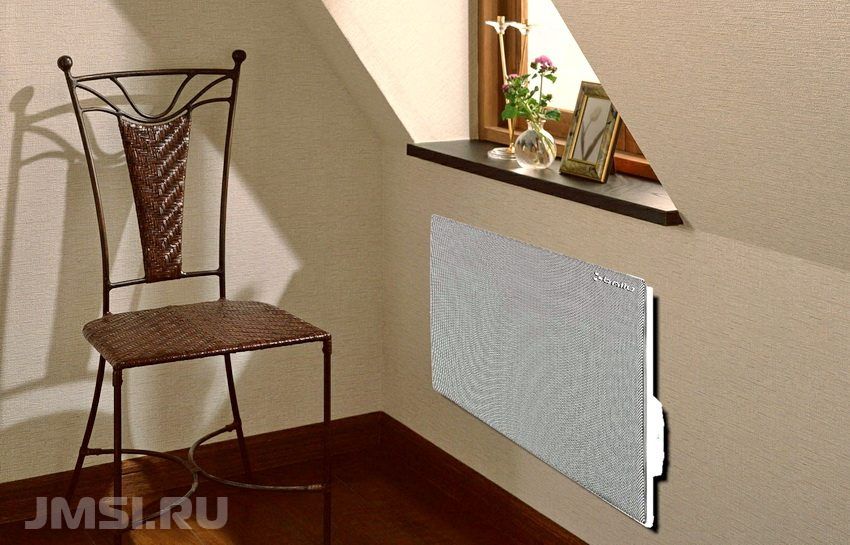
Wall-mounted infrared heater convector type
Prices of oil electric heaters and convectors
The price category of the heating device depends on its power, manufacturer, availability of additional functions and other characteristics. The price of an oil household electric heater of small capacity will be about 2500 rubles. The cost of more powerful models is in the range of 3-4 thousand rubles. The price of the device is affected by the heating area and the number of sections.
When choosing a convector, you must also pay attention to the power and manufacturer. Here the price can vary from 1500 to 4500 rubles. are cheaper, you can buy such a heater for 1000 rubles and less.
If you want to buy an oil heater DeLong, then be prepared for serious expenses, as the products of a well-known brand are more expensive. If you do not want to overpay for a trademark, you can turn your attention to heating devices from lesser-known companies.
Which heaters are better: oil or convector?
To fully understand what is better, convector or oil heaters, you need to compare their main characteristics with each other:
- time of air heating in the room. In the oil radiator, the heating element is first heated, then it heats the oil, which gives off heat to the body, which is already starting to heat the air. In the convector air heating occurs immediately. It should be understood that if you are going to buy an electric oil heater with a fan, it will warm the air at the same speed as the convector, or even faster. This is due to the relatively low power of the convector heater;
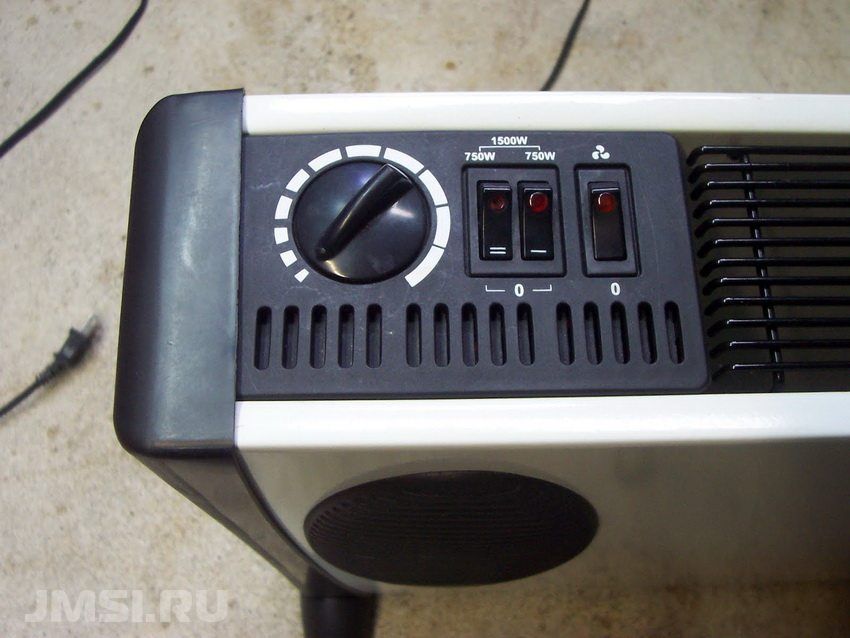
When choosing a device, pay attention to such an important characteristic as power
- electricity consumption. In this regard, the convector is about a quarter more economical than an oil radiator of the same power. This factor can be decisive, since the solid energy consumption of the oil device can fly into a pretty penny;
- ease of installation and operation. Convectors weigh several times less than bulky oil devices, so moving them from place to place is much more convenient. In addition, they are easier to mount on the wall, although this reduces the efficiency of the work. Modern models of devices of both types are equipped with sensors, simple and clear controls and displays, so that the level of ease of operation is about the same and depends largely on the manufacturer and model;
- safety of use. The answer to the question what kind of oil heaters may well be the best - those that are less heated during operation. The red-hot oil noticeably heats up the body, but the convectors in this regard are completely safe. You can easily leave such a device turned on without supervision, while it is extremely not recommended to do this with oil;

Compared to oil heaters, convectors are more secure
- environmental friendliness and safety for health. Oil or convector heaters do not have parts in their design that could burn oxygen, so in this regard, both types are completely safe. When the convector is in the room, dust may circulate, which is not the case when the oil heater is operating. But a lot depends on the cleanliness of the room;
- durability. Convector heaters last significantly longer than oil heaters, and repairing them is much easier. One of the most common causes of breakdowns in an oil cooler can be the occurrence of microcracks, through which oil flows and evaporates. Repair in such cases is very complicated or simply impossible;
- cost Oil radiators are cheaper than convectors of the same power, but in terms of the aggregate performance characteristics are much inferior to them, so the savings can be very doubtful.
In addition to the characteristics already listed, it is worth noting that the improvement of convector heating devices is much faster than oil, which slowly but surely disappear from the market. The latest invention in this regard is the monolithic heating element of the convector, which doubles the thermal power of the device with the same electricity consumption.

The device of a modern convector heater
In addition, when choosing a convector or an oil heater, it is necessary to take into account the degrees of protection, and according to this characteristic, the latter clearly loses. Rare convector is not equipped with protection against overheating, voltage surges and overturning. While oil radiators are often found without any protection at all.
Convector or oil heater: what is better to buy for home and office
Considering all the characteristics considered, it can be said that convector-type heaters have more advantages than oil ones. But this does not mean that the latter have completely lost their positions and are not used anywhere. Radiators with oil as a coolant are cheaper than other types of heaters, which still makes them very popular. Also, an oil cooler can be effectively used where fast air heating is not needed, but its uniformity is appreciated. And models with a built-in fan can warm up a room even faster than a convector.
When choosing a heater model for your apartment or office, consider the combination of its characteristics, manufacturer's reputation and other factors. A good oil cooler will be more efficient than a low quality convector. An important role when choosing reviews also play. What is better, oil heaters or convectors of one type or another can be found in the reaction of users on the Internet.
Complete set and device of oil heaters
They get these heaters because of the ease of use and good efficiency of heating the room. Structurally, the oil radiator has a steel case, with filled-in oil. In the design installed PETN, which heats the oil. Further, the oil heats metal fins, which heat the room air.
Complete oil radiators with a temperature controller, a place for a cord and an integrated fan. The fan increases the efficiency of heating the air in the room. Also, radiator enclosures can be equipped with a protective grille to protect a person from accidentally touching the hot walls of the enclosure.
On all oil radiators install swivel castors for easy movement. Overheating protection is also installed on these devices, and on some models they install tipping sensors. In case of a fall of the radiator, the sensor disconnects it from the network, which increases electrical safety.

Oil heaters
The thermostat can be set to the desired temperature, and if there is also a timer, then you can schedule the radiator to turn on at the right time. The advantage of such heaters can be attributed to the low cost, noiselessness, ease of movement.
Choose the power of these heaters at the rate of 1 kW per 10 m² at ceilings below 3 meters. Oil radiators can be electronic temperature control devices or mechanical, in the form of a rheostat.
Convector Heaters
If oil radiators are designed for installation on the floor, the convectors are hung on the wall. They have a special mount for installation on the wall. However, you can find convector heaters mounted on rotary wheels. There are also baseboard convectors measuring 15 cm in width and 1.5 meters in length.

Work and device convector heater
Convectors heat the air in the room with only one side. The rooms are heated due to the movement of warm and cold air. The heated cold air mass moves upwards, and the next portion of cold air replaces it. Convectors do not make noise. The heating of the room by the convector occurs evenly.
The device has a convection chamber with a heating element built into the housing. A feature of the convector heater is a quick and uniform heating of the room. The heated air moves through special slots and is directed to the walls and floor.

Convector heaters
When heated, air accumulates inside the heater and attains a certain pressure in portions through the slots in the horizontal direction. On the case of the convector there is no ground terminal. This is caused by a special fastening of the heating element to the body through an insulating plastic.
Placing convectors in each room can replace an expensive boiler. If a thermostat is installed on the convector, then you can still save on electricity.
Which heater is better oil or convector
Comparison of oil and convector heater.
Saving. When comparing economic indicators, a convector consumes 25% less electricity than an oil radiator.
Warm-up time. The design of the oil heater is designed in such a way that the oil is first heated by the heater, and then only the heated case transfers heat to the room. Installed fans somewhat reduce the time of heating the room. The convector in this case heats the room faster, the heat of the heating element in it is immediately transferred to the device body.
Efficiency Convectors is quite high, and is 95%. However, the rate of space heating in convectors is not large and an oil cooler with a fan would be preferable in this case.
Convenience in operationand. Convectors 2 times lighter than oil. Convector device is easily mounted on the wall and more convenient to move on wheels on the floor. The heating temperature of their air is more uniform and more favorable for the person.
Fire hazard. Here preference can be given to a convector heater as safer. You can get burned on the oil heater, and the collector heats up to 60 ° C, which is safe. For oil heaters without an overheating sensor, you need a constant presence.
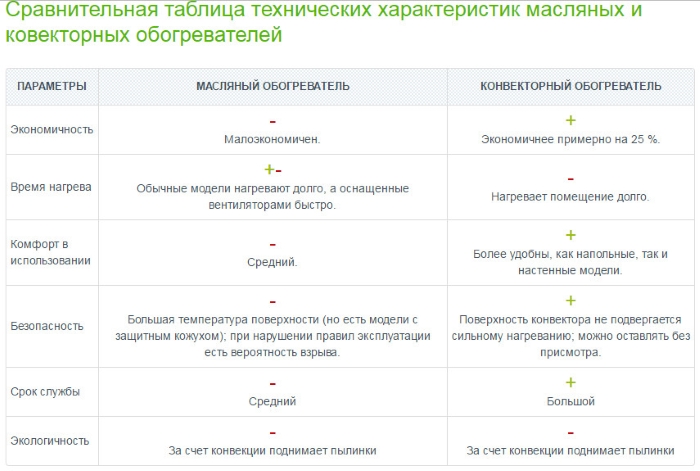
Comparison table of oil heaters and covectors
Life time. Oil radiators do not last long. Over time, microcracks appear, through which oil flows and the device fails. They are not subject to repair. Convectors serve 15 years or more with a 5 year warranty specified in the instructions.
Indoor dust rises with air movement in all heaters. This applies to the oil heater and convectors. Oxygen of this type of heaters do not burn because there is no open fire.
Cost of oil radiators are noticeably lower than convectors, but here it is necessary to take into account the durability and quality of heating the room.
It is possible to make an unequivocal conclusion: it is better to purchase convectors, they are light, convenient to operate, safe and silent.
